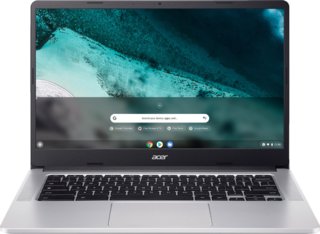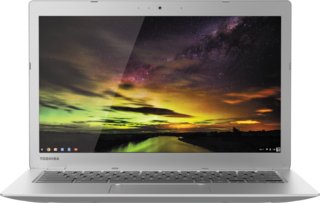Acer Chromebook 314 14" Intel Pentium Silver N6000 vs Toshiba Chromebook CB35 13.3" Intel Celeron N2840
Let's explore Chromebooks, focusing on two models in particular: the Acer Chromebook 314 and the Toshiba Chromebook CB35. The Acer 314 stands strong, powered by an Intel Pentium Silver N6000 processor that easily manages daily tasks. It impresses with a generous 8GB RAM for seamless multi-tasking, while its stylish and modern design will appeal to those who appreciate a current aesthetic.
The Toshiba CB35 features an Intel Celeron N2840 processor, suitable for everyday tasks. Its compact and lightweight design makes it ideal for users who are often on the go.
When comparing these two laptops, a few key differences stand out. The Acer model, equipped with a Pentium Silver N6000 processor and 8GB of RAM, offers superior performance and better multitasking capabilities than Toshiba's Celeron N2840 with usually only around 4GB of RAM. However, Toshiba shines in portability; its compact design makes it much easier to carry around compared to the bulkier Acer. So, if you need a powerhouse for multitasking, go with Acer. But if you prioritize lightweight convenience, Toshiba is your go-to.
Both laptops excel in different areas - Acer offers strong performance, while Toshiba prioritizes portability.
System and application performance
Performance in popular 3D games
Viewing angle, color accuracy...
Ports, webcam and other interfaces
Potential battery life
Materials, durability and portability
Design Comparison
Size Comparison
Let's explore how the design features of the Acer Chromebook 314 and the Toshiba Chromebook CB35 affect practical usability and visual appeal to cater to various user requirements.
Acer Chromebook 314
Design Elements:
Ergonomics: With its 14-inch screen, this device enhances the viewing experience, making it ideal for content creation or research tasks that demand prolonged screen engagement.
Materials & Build Quality: With its compact dimensions and lightweight design weighing 3.2 pounds, this device is portable for students or professionals who require frequent mobility.
Portability: Its sleek design, measuring just 0.8 inches thick, prioritizes ease of transport while maintaining full functionality.
Unique Design Feature: The inclusion of a touch screen adds versatility to interactions, enabling intuitive navigation and input methods for various tasks.
Toshiba Chromebook CB35
Design Elements:
Ergonomics: Although slightly smaller with a 13.3-inch screen, the device remains practical for everyday use while offering a good balance between portability and screen real estate.
Materials & Build Quality: Weighing in at 3 pounds and boasting compact dimensions, users can effortlessly carry it without any added weight.
Portability: Its sleek design makes it easy to carry around, perfect for busy professionals or students who are always on the move.
Practical Usability and Aesthetic Appeal:
- Students: For students requiring larger screens for research or multimedia projects, the Acer Chromebook 314 may offer better usability due to its bigger display size.
- Professionals: Professionals seeking a balance between portability and screen space may find the Toshiba Chromebook CB35 more appealing due to its slightly lighter weight.
Impact on User Experience:
The touch screen feature in the Acer model boosts productivity with intuitive interactions like drawing or note-taking. Both laptops have a similar design that prioritizes portability and build quality, making them ideal for users who value easy transport without sacrificing durability.
Screen Comparison
| Acer Chromebook 314 14" Intel Pentium Silver N6000 | Toshiba Chromebook CB35 13.3" Intel Celeron N2840 | |
|---|---|---|
| Resolution | Full HD | HD |
| Screen Size | 14" | 13.3" |
Comparing the screen features of the Acer Chromebook 314 and the Toshiba Chromebook CB35 reveals key differences that greatly influence user experience, particularly for activities such as gaming or professional graphic design.
Screen Size:
- Acer Chromebook 314: Boasts a roomier 14-inch screen for an immersive viewing experience and increased screen space for multitasking or enjoying multimedia content.
- Toshiba Chromebook CB35: With a slightly smaller 13.3-inch screen, it offers enhanced portability but may constrain multitasking capabilities when handling numerous windows or applications at once.
Screen Resolution:
- Acer Chromebook 314: Features a resolution of 1920 x 1080 pixels, providing sharper images and text for improved clarity. This resolution is perfect for intricate graphic design tasks or enjoying high-definition content.
- Toshiba Chromebook CB35: With a resolution of 1366 x 768 pixels, it falls below the Acer model's display quality. Although adequate for daily tasks, this resolution may lack the detail and sharpness of a higher-resolution screen.
Pixel Density:
- Acer Chromebook 314: Boasting a pixel density of 157 pixels per inch (ppi), this model delivers sharper details and seamless visuals, elevating your viewing experience with enhanced vibrancy and realism in images and text.
- Toshiba Chromebook CB35: With a pixel density of 117 ppi, it offers slightly lower sharpness and detail compared to the Acer model. This may affect tasks that demand precision or attention to detail.
Display Technology:
- Acer Chromebook 314: Features an LCD IPS LED-backlit display for vivid colors, broad viewing angles, and improved color accuracy. The IPS technology ensures clear visibility from different perspectives with minimal color distortion.
- Toshiba Chromebook CB35: Features an LED-backlit LCD display technology. While LED-backlit displays offer energy efficiency and brightness, an IPS panel like that in the Acer model typically provides superior color reproduction and viewing angles.
Touch Screen Capability:
- Acer Chromebook 314: Equipped with a touch screen feature, enabling users to directly interact with on-screen elements through touch gestures. This functionality proves advantageous for tasks demanding accurate input or creative endeavors such as drawing or design.
- Toshiba Chromebook CB35: Does not have a touch screen functionality. While some users may not require touch capabilities for their tasks, others might find it useful in scenarios where direct interaction with the screen is desired.
In conclusion, if you prioritize a larger screen size with higher resolution, better pixel density for detailed visuals, superior display technology like IPS for accurate colors and wider viewing angles, as well as touch screen functionality for creative tasks or interactive use cases such as gaming or graphic design, the Acer Chromebook 314 would be the preferable choice. On the other hand, if portability is paramount over these specific display features or if budget constraints are a concern, the Toshiba Chromebook CB35 could still serve well for general everyday needs but might fall short in delivering an optimal visual experience for more demanding tasks.
Hardware Comparison
| Acer Chromebook 314 14" Intel Pentium Silver N6000 | Toshiba Chromebook CB35 13.3" Intel Celeron N2840 | |
|---|---|---|
| CPU | Intel Pentium Silver | Intel Celeron N2840 |
| RAM | 8GB | 2GB |
Let's dive into a detailed comparison of the hardware aspects between the Acer Chromebook 314 and Toshiba Chromebook CB35. To truly understand how these components affect practical applications, it's crucial to examine key elements like CPU, GPU, RAM, and storage.
Acer Chromebook 314 (14" Intel Pentium Silver N6000 1.1GHz / 8GB RAM / 64GB SSD)
- CPU: Intel Pentium Silver N6000Performance Impact: This processor boasts a CPU speed of up to 4 GHz and 4 threads, making it proficient in managing various tasks concurrently and handling light to moderate computing work effectively.
- RAM: 8GB RAM (2933 MHz)
- Performance Impact: The ample RAM capacity allows for smooth performance when running multiple applications simultaneously or engaging in basic multimedia tasks.
- Storage: 64GB SSDPerformance Impact: The SSD boosts boot times and application loading speed over traditional HDDs, improving overall system responsiveness.
Toshiba Chromebook CB35 (13.3" with Intel Celeron N2840 2.16GHz, 2GB RAM, and 16GB Storage)CPU:
- Intel Celeron N2840 running at 2.16GHzPerformance Impact: The lower CPU speed may result in slower performance when handling more demanding applications or multitasking scenarios, despite being able to handle basic computing tasks.
- RAM: 2GB RAM
- Performance Impact: Limited RAM capacity may result in performance bottlenecks when running multiple applications simultaneously or engaging in memory-intensive tasks like video editing.
- Storage: Internal Storage: 16GB
- Performance Impact: The limited storage space can be a constraint for users requiring ample space for files, software installations, or media storage.
Comparison Summary:
- The Acer Chromebook 314 stands out for its strong CPU performance and ample RAM capacity, ideal for handling multiple tasks and multimedia activities. The Toshiba Chromebook CB35, on the other hand, provides fewer resources compared to the Acer Chromebook
- This includes less RAM capacity and internal storage, potentially affecting its performance when running resource-intensive software.
- The Acer Chromebook 314 is a strong choice for users who value performance and versatility in their daily computing requirements, offering more durability than the Toshiba Chromebook CB35.
Choosing the right laptop tailored to individual needs requires a deep understanding of how each component impacts overall performance. The Acer Chromebook 314 stands out as an excellent option for users looking to boost multitasking efficiency and achieve seamless operation across different applications, surpassing the Toshiba Chromebook CB35.
Battery Comparison
| Acer Chromebook 314 14" Intel Pentium Silver N6000 | Toshiba Chromebook CB35 13.3" Intel Celeron N2840 | |
|---|---|---|
| Battery Life | 11.5 hours | 9 hours |
When comparing the battery performance of the Acer Chromebook 314 and the Toshiba Chromebook CB35, there are some key differences to consider:
Acer Chromebook 314 with a 14-inch display, Intel Pentium Silver N6000 processor running at 1.1GHz, 8GB RAM, and 64GB SSD:
- Battery Life: Up to 11.5 hours
Toshiba Chromebook CB35 13.3" with Intel Celeron N2840 processor, 2GB RAM, and 16GB storage capacity:
- Battery Life: 9 hours
- Sleep And Charge USB Ports: true
Here's a breakdown of how these laptops compare in terms of battery performance:
Acer Chromebook 314: The Acer Chromebook boasts an impressive battery life of up to 11.5 hours, catering to users requiring a device that can sustain them throughout the day without the need for frequent recharging.
- Users can enjoy extended battery life, allowing for uninterrupted usage, ideal for students, professionals, or busy individuals.
Toshiba Chromebook CB35: The Toshiba Chromebook offers a solid battery life of up to 9 hours, suitable for typical daily tasks but slightly less than the Acer model.
- Furthermore, the incorporation of Sleep And Charge USB Ports in the Toshiba model enables users to charge their devices while the laptop is in sleep mode, providing extra convenience.
In conclusion, both laptops provide good battery performance for daily use. The Acer Chromebook 314 excels with a battery life of 11.5 hours, surpassing the Toshiba Chromebook CB35's 9-hour battery life.
Verdict
Why Acer Chromebook 314 14" Intel Pentium Silver N6000?
- Acer Chromebook 314 offers a more powerful Intel Pentium Silver N6000 processor for better performance.
- Acer Chromebook 314 comes with 8GB of RAM compared to Toshiba's likely lower RAM, enhancing multitasking capabilities.
- Acer Chromebook 314 features a larger 14-inch screen for improved viewing experiences and productivity.
- Acer Chromebook 314 provides a longer battery life of up to 11.5 hours, ideal for uninterrupted usage throughout the day.
Why ?
- Toshiba Chromebook CB35 offers enhanced portability with a compact and lightweight design.
- The Toshiba model provides a good balance between portability and screen real estate.
- Toshiba Chromebook CB35 may be more budget-friendly compared to Acer Chromebook 314.
- The inclusion of Sleep And Charge USB Ports in the Toshiba model adds convenience for charging devices on the go.
Similar comparisons
- Acer Chromebook 314 14" Intel Celeron N4500 vs Toshiba Chromebook 2 CB35 13.3" Intel Celeron 3215U
- Acer Chromebook 15 C910 15.6" Intel Celeron 3205U vs Acer Extensa 15 EX215-54-316R Intel Core i3-1115G4
- Acer Chromebook 15 15.6" Intel Celeron 3205U vs Toshiba Chromebook 2 CB35 13.3" Intel Celeron 3215U
- Acer Chromebook 14 CP5-471 14" Intel Celeron 3855U vs Toshiba Chromebook 2 CB35 13.3" Intel Core i3-5015U
- Acer Aspire One Cloudbook 14 AO1-431 14" Intel Celeron N3050 vs Dell XPS 13 9350 13.3" Intel Core i5 6200U

